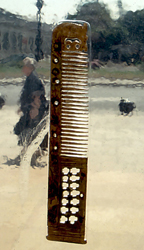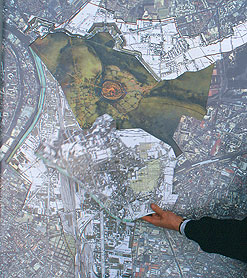- Home
- Archaeology, territory and citizenship
- Archaeology and citizenship
- Reading the town
Historical walking tour: location of the markers.
© J. Kiras.
Reading the city in order to experience it on a daily basis and to discover it, making the effort to understand this perpetually changing space, and training future citizens. To make all this possible, the Archaeological Unit uses its research on the town's historical topography to create an original set of tools that encourage the public to come into contact with the town.
Historical walking tour : educational dossier no. 2
The "From Saint Denis to Saint-Denis" historic walking tour
Since 1998, the path from the basilica to the Stade de France has been turned into a historical walking tour. Twenty steel markers are inscribed with the various stages of development of the town, from its very beginning to the twenty-first century. Each one features, embedded in resin, copies of objects that symbolize a period or an activity, and explains the town's economic and political development. This creation was the result of collaboration between an artist, Jean Kiras, an historian, Luc Fauchois, and the Archaeological Unit. It received support from the town, the Seine-Saint-Denis Conseil Général, and JCDecaux.
Historical walking tour: block set in marker no. 4, displaying a replica of a Carolingian-era comb.
© UASD / S. Louit.
Historical walking tour: marker no. 11, which discusses fairs and trade in the Middle Ages.
© UASD / S. Louit.
The walking tour is considered to be a mediator in the strict sense of the term, because it carries an image of the town that is charged with reconciling the visitor or the pedestrian with this same town. In terms of a tool for understanding, it allows the inhabitants to discover urban reference points, and helps them to better understand the changes that their town has experienced. Teachers may extend this walking tour through two educational dossiers, entitled Saint-Denis quelle histoire ! (Saint-Denis, What a Story!).
In additional sixty markers complete this walking tour. They are simpler and smaller and are distributed throughout the town. They inform the passerby about various structures, both those that are visible and those that have disappeared.
The "Changeable Model of the Territory": the Ludambule.
© UASD.
The Changeable Model of Saint-Denis and the "Ludambule"
The Changeable Model is a large suitcase that contains the principal stages in the development of the territory, from the Carolingian period to the present. It takes the form of puzzle-maps that stack atop each other, like archaeological strata, allowing the map of Saint-Denis to be read chronologically. Transparent overlays allow users to develop thematic approaches, such as the hydrographic network, paths of communication, industrialization, the major projects of the twenty-first century, etc.
The goal is to help the residents of Saint-Denis read the urban space, by constructing and deconstructing it, while at the same time offering them a chance to meet and discuss their town. The model is used in secondary schools, residences for the elderly and neighborhood meetings, where it may accompany the presentation of urban development projects. This prototype is completed by the "Ludambule", a board game in which players combine thought and strategy to carry out an investigation in connection with a specific period of history. The Changeable Model-which was designed by the Archaeological Unit, the communication service and the town's games libraries-received State support within the framework of the policy of Saint-Denis and that of the Innovation and Territorial Action Office of the Ile-de-France Regional Cultural Affairs Department.
The "Changeable Model of the Territory": superimposed puzzle-maps.
© UASD / S. Louit.






